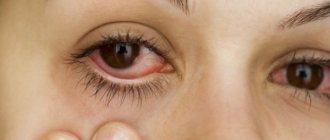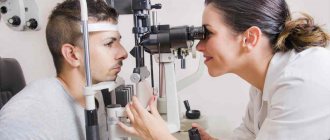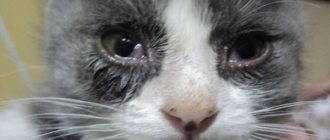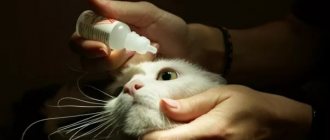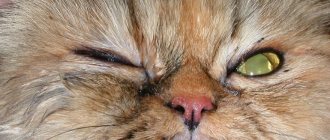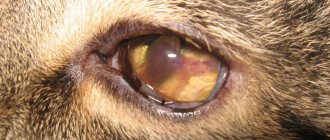7975Pavel
1
Many animal lovers don't limit themselves to just one pet in the house. Well-bred animals get along well with each other. But sometimes misunderstandings happen even between the best friends. So, let’s answer the question, what to do if a cat scratches a dog’s eye? Please note that the provocateur of a fight is often a cat. It is she who most often becomes the culprit of the damage caused.
Firstly, the danger posed by a cat's claw should not be underestimated. The consequences of a cat scratching a dog's eye are the saddest. Up to loss of vision, and in case of particularly severe damage, even the eye itself. It is very important to know how to provide first aid to an animal because a lot depends on it.
© shutterstock
The need to contact a veterinarian
If a cat scratches a puppy's eye, you should also not self-medicate. Even if at first glance you do not notice any visible damage, it is possible that within a day the eye will begin to become cloudy. And if at first the clouding is noticeable only in bright daylight, then it will become more and more significant and without veterinary care may become irreversible. The consequences of such delays can be seen in the video.
Keratitis also cannot be treated on its own or through telephone consultations with a veterinarian.
. If the dog begins to actively and frequently rub its eyes, and even more so if tears, mucous discharge or pus begin to come out of the damaged eye, a visit to the veterinarian should be made immediately, without wasting a single extra hour of time. Delay may result in your dog becoming completely blind. Moreover, today there are often cases when, during a fight or overly active games, a cat injures both eyes of a dog at once.
There are some differences in advice depending on where exactly the dog was injured and what kind of cat the injury was caused. The fact is that if a dog is injured by a stray animal, in addition to the purely surgical consequences of the injury, there is also the risk of additional complications. We are talking about infection with tetanus or rabies. You cannot decide on your own how to treat an animal; you need to immediately go to a veterinary clinic and save your pet. A delay of just one day can become irreversible.
Traumatic eye injuries are a very serious problem and, in the worst cases, can lead to blindness or loss of the eye. Therefore, as a rule, a pet with an eye injury requires urgent qualified help.
No one is immune from injury, but there is a risk group. Cats walking on the street, brachiocephalic (due to anatomical features) and hunting (due to lifestyle) breeds of dogs.
Causes
Damage to the eye apparatus is a fairly common reason why dog owners seek help from a specialist. In most cases, injury to the organ of vision occurs due to the following factors:
- The pet loves to chase cats. This “centuries-old enmity” often ends very badly. Not only can a dog injure his eyes during the chase, for example, by catching on a branch or twig, but also the cat’s claws are a dangerous weapon that can deprive the unlucky “hunter” of sight.
- During various festivals, especially in winter, animals whose eyes have been injured by firecrackers or fireworks often come to see a doctor. For many of them, such injuries result in complete blindness.
- Hunting breed dogs are at constant risk. The very nature of their activity is often full of factors damaging the ocular apparatus: dry stubble, reeds, spruce branches, sand and twigs. The eyelids take on an avalanche of damage, which can cause them to swell and, over time, become inflamed.
- Young and inexperienced pets can damage their eyes when playing too long with another animal or owner.
- For service and fighting dogs, the chance of losing an eye is especially high, this is due to the functions that the owner assigns to them.
Treatment
If you suspect an eye injury, you should take your dog to a veterinary clinic as soon as possible. The dog is in severe pain and discomfort; do not attempt to examine or treat the injured eye yourself. Before being examined by a doctor, it is necessary to protect the dog’s eye from additional injury (protective collar). Do not use any eye medications without a doctor's prescription. For corneal wounds, any additional impact to the head, neck, or eye can result in corneal rupture.
Many animal lovers don't limit themselves to just one pet in the house. Well-bred animals get along well with each other. But sometimes misunderstandings happen even between the best friends
So, let’s answer the question, what to do if a cat scratches a dog’s eye? Please note that the provocateur of a fight is often a cat. It is she who most often becomes the culprit of the damage caused.
Firstly, the danger posed by a cat's claw should not be underestimated. The consequences of a cat scratching a dog's eye are the saddest. Up to loss of vision, and in case of particularly severe damage, even the eye itself
It is very important to know how to provide first aid to an animal because a lot depends on it.
First aid
If a dog has an eye injury, treatment should be carried out by a veterinarian, and it is better to do this as soon as possible. But first aid must be provided until the pet is delivered to the clinic.
It is necessary to prevent the animal from scratching the damaged organ on the way to the veterinary clinic. If possible, use a specialized collar or simply hold the dog by the paws when trying to scratch.
To reduce the pet's pain, local anesthesia by instilling a 2% novocaine solution is recommended. It is advisable to have such a medicine with you, especially when going hunting in the first aid kit.
If a dog does not allow its eyes to be opened, you should not force it open, even to administer anesthesia. Otherwise, you can only injure him more; such a task should be left to a specialist.
As an exception, if it is not possible to immediately show your pet to a doctor, you need to instill eye drops for the dog, these are antibiotics (Tsiprovet, Gentamicin, Torbex). The dose must be calculated according to the instructions for the drugs based on the body weight and size of the dog.
Diagnostics
When making a diagnosis, the doctor takes into account the history and physical examination.
This is especially important in case of blunt trauma to the eye, since, in addition to the eye, the vital organs of the animal can be seriously injured (for example, in a car accident or other strong impact). A chest x-ray and abdominal ultrasound may be recommended
The presence of signs of trauma to the facial region (orbit, nose, oral cavity) is assessed. An X-ray of the head may be required.
A complete ophthalmological examination is performed and a fluorescein test is used to identify corneal defects. If necessary, ultrasound of the eye. Due to severe pain, the patient may need to be sedated for examination if local anesthetics are not sufficient.
If a traumatic brain injury is suspected, a neurological examination is performed.
Additionally, a CT or MRI of the head may be required.
Redness of the eye
If the whites of the eyeball, usually white, become red, this may indicate an increase in both intraocular and general pressure, and the presence of an inflammatory process. Perhaps the injury went unnoticed, and we see a hematoma. Any of the options requires diagnosis, and if it turns out that the redness of the eye structures was a sign of an allergic reaction, then consider yourself off easy. All other disorders require emergency treatment, because if it is an increase in intraocular pressure, then there is a risk of losing the eye, and if it is a hematoma, then the task is to prevent the development of blindness. It is necessary to exclude hematomas (hemorrhages) in the fundus, check the safety of all intraocular structures, and assess the neurological status of the animal as a whole.
The use of nonspecific treatment in this case does not make sense.
What not to do
Under no circumstances should you apply any means to stop bleeding or disinfect the injured eye before traveling. Exposure to such drugs will often only worsen your pet's injury, or even make it irreversible. You should not try to blot the surface of the eye with all kinds of napkins, and you should not press on the damaged surface.
Types of eye damage in dogs
In the worst case scenario, the pet may completely lose its organ of vision. Damage and its causes are varied, which will be discussed below.
Mechanical injury
The cause of a mechanical injury may be a skirmish with another dog, an unsuccessful encounter with a cat, or the pet may simply stumble upon a branch or sharp object. The severity of the damage also varies.
The most dangerous situation is an injury to a dog’s eye with a sharp object, when the cornea is damaged and various bacteria and microbes penetrate into the wound and, as a result of their vital activity, can provoke complete loss of vision.
It is worth paying attention if the dog begins to squint or has completely closed its eye, purulent or bloody discharge occurs from the corners, and the pet does not allow itself to be examined, prevents the opening of the eyelid, and is clearly in pain - it is necessary to promptly show the animal to a veterinarian-ophthalmologist. There is a chance to prevent vision loss, but surgery may be required
Damage may be internal and invisible. Blunt trauma to a dog's eye can cause retinal rupture or detachment, internal hemorrhage, and swelling of the optic nerve. So if there is a suspicion of injury, it is better to show the animal to the doctor, it will be easier to avoid complications.
Redness of the eyes
The causes of redness vary. Perhaps a foreign object has gotten under the third eyelid, scratching the cornea and causing irritation. The foreign body should be removed and the animal should be shown to a doctor to ensure that it has been completely removed and there is no risk of developing other problems.
It is especially important to take a closer look at the nature of the redness, if it looks more like a pinkish film - there is a risk that the pet has developed the so-called pannus - clouding of the surface layer of the cornea. If you do not see a doctor in time, there is a risk of vision loss
By the way, another cause of redness and irritation of the organs of vision may be an inversion of the lower eyelid, which is not an injury, but significantly interferes with the comfortable existence of the pet. The eyelashes of the rolled eyelid scratch the cornea, causing irritation and increased tearing. The issue is resolved surgically.
It could also be caused by high blood pressure or an allergic reaction.
Purulent discharge
If first clear and then purulent discharge is detected, accompanied by swelling of the eyelid, this is a sign of conjunctivitis, inflammation of the mucous membrane of the eyelid. In the case of thick, cloudy discharge, the cause is most likely an infection, although the development of the disease may be associated with injury. For example, with the entry of a foreign body.
It happens that conjunctivitis develops as a concomitant disease as a result of a general decrease in immunity. Despite the fact that conjunctivitis is not so difficult to cure, the dog should be shown to a doctor in order not only to make a correct diagnosis, but also to find out and eliminate the cause of the disease.
Eyeball prolapse
In some cases, an eye injury in a dog can provoke a very unpleasant consequence - apple loss. A similar situation often happens with representatives of brachycephalic breeds (Pekingese, bulldogs, pugs, etc.) A feature of representatives of such breeds is a flattened muzzle and bulging eyes.
If such a situation occurs, the main thing is not to panic
The best option is to put the apple back in place as carefully as possible and, to save your pet’s vision, immediately take him to an ophthalmologist or surgeon. Apply a damp gauze bandage and do not allow it to dry until the animal reaches the doctor.
Increase
Sometimes it happens that one eye becomes enlarged, and occasionally both. This is also a reason to sound the alarm, grab the animal in your arms and rush to the veterinarian.
In this situation, the doctor will measure the pressure, examine the fundus of the eye, and most likely conduct a blood test. Based on the test results, the cause of the increase in pressure will be determined.
Swelling
If a red swelling appears, do not panic; in most cases it will not be a tumor or adenoma. Most likely, this is an inversion of the lacrimal gland or lower eyelid that needs to be realigned.
Otherwise, there is a risk of developing “dry eye syndrome,” which will then have to be treated for the rest of your pet’s life. There are also very unpleasant consequences that can develop: corneal ulcer, keratitis or conjunctivitis.


